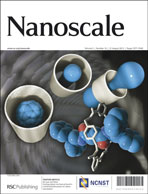RNase non-sensitive and endocytosis independent siRNA delivery system: delivery of siRNA into tumor cells and high efficiency induction of apoptosis
Abstract
To date, RNase degradation and endosome/lysosome trapping are still serious problems for siRNA-based molecular therapy, although different kinds of delivery formulations have been tried. In this report, a cell penetrating peptide (CPP, including a positively charged segment, a linear segment, and a hydrophobic segment) and a single wall carbon nanotube (SWCNT) are applied together by a simple method to act as a siRNA delivery system. The siRNAs first form a complex with the positively charged segment of CPP via electrostatic forces, and the siRNA–CPP further coats the surface of the SWCNT via hydrophobic interactions. This siRNA delivery system is non-sensitive to RNase and can avoid endosome/lysosome trapping in vitro. When this siRNA delivery system is studied in Hela cells, siRNA uptake was observed in 98% Hela cells, and over 70% mRNA of mammalian target of rapamycin (mTOR) is knocked down, triggering cell apoptosis on a significant scale. Our siRNA delivery system is easy to handle and benign to cultured cells, providing a very efficient approach for the delivery of siRNA into the cell cytosol and cleaving the target mRNA therein.


 Please wait while we load your content...
Please wait while we load your content...